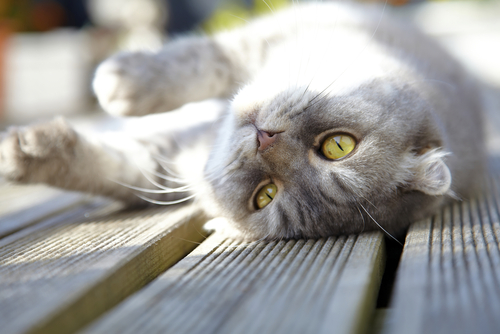
Photo: Shutterstock
Female cats or queens are seasonally polyestrus, which means they keep coming back into heat every seven to ten days until they are bred. Female heat cycle in cats depend on the seasons. Primarily they have heat cycles between January and September. This mating season is also influenced by the length of daylight, the presence of other cats and the temperature conducing the atmosphere. Cats kept indoors and exposed to artificial lights may cycle year-round.
When optimal conditions are met, and there are 12 hours of daylight during the day, the female cat begins its estrus cycle and the hormonal system starts up. After this, every seven to ten days, the cat keeps going on heat. This will happen until the daylight timings decrease.
The stages of the estrus cycle are:
Anestrus: This usually occurs in the winter when the days are shorter. During this time, the female cat won’t experience any heats and there is no attraction between cats of opposite sexes.
Proestrus: After the cycle begins, the proestrus stage can last as long as one or two days or as short as a few hours. You may notice that the female cat gets quite vocal at this stage as she calls for a male. However, she will not let the tom cat come near her. Instead, you’re likely to see her rolling on the floor or rubbing herself against objects or people. There is no bleeding in female cats during proestrus as there is in female dogs.
Estrus: This stage lasts for around a week, during which the queen displays the same behavior as it does at the proestrus stage. Female cats also urinate frequently and assume a breeding position at this stage, characterized by their head and front legs being close to the ground and their bottom held high above. The tom cat or cats will be allowed to mate with the queen at this stage. Mating could last for a few seconds to under half a minute. It’s even possible for a single litter to have more than one father. This phenomenon is known as superfecundation.
Interfollicular (interestrous stage): If a queen has not been mated and bred during the previous stage, she will proceed to the interfollicular or interestrous stage, which lasts for about a week. During this time, there are no signals from the cat to indicate reproductive activity. From this stage, the queen will cycle back to proestrus and estrus again.
Diestrus: The diestrus stage lasts from 5 to 7 weeks. It occurs when cats that are ovulating and have been mated do not become pregnant. Queens can appear to be pregnant at this time, even though there are no signs of reproductive activity. Pregnant cats have a gestation period of about 63 days.
Cats generally start puberty when they are around six to nine month old, but some cats can start their mating cycle and become pregnant from as young as five months old. If you do not wish for your cat to breed, spaying will prevent pregnancy and signs of your cat being in heat.
Please like FamiLife’s page on Facebook so that you get all our articles and others may find us.
